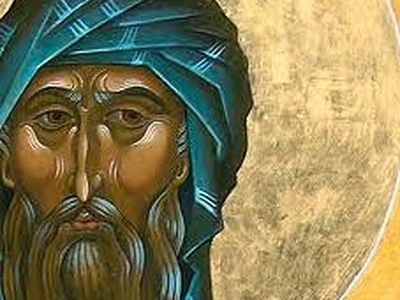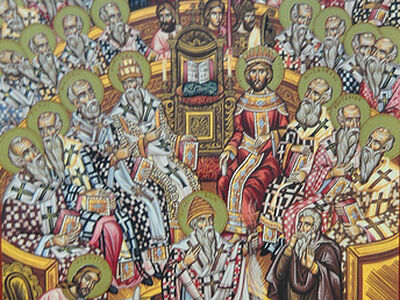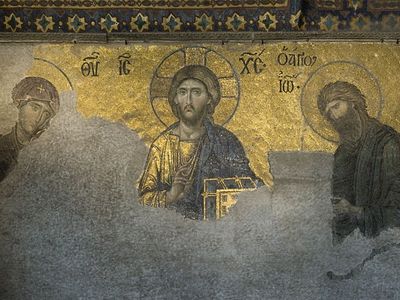On this Sunday which falls between July 13/26 and July 19/August 1 the holy Orthodox Church commemorates the holy Fathers of the first six Ecumenical Councils who labored with much love and suffering to preserve the truth of the God-Man Jesus Christ for the sake of our salvation. True theology is necessarily bound up with and feeds into true practice and spirituality, and thus it is necessarily bound up with our never-ending pursuit of perfection in Christ. The proclamations of the Ecumenical Councils are received as infallible and unassailable witnesses to Orthodox Tradition.
However, there are those today who seek to downplay and sometimes even overturn the importance of these Councils and the God-seeing holy Fathers who labored at them for the sake of "unifying" the true Church of Christ with other, unOrthodox bodies.
Against this tide Protopresbyter Theodore Zisis, Professor Emeritus of the School of Theology, Aristotle University of Thessaloniki has risen up as a staunch defender of the Patristic phronema of the holy Orthodox Church, speaking the truth in love. He seeks to present to his audiences Patristically-sound theology in a clear and practical manner. A biography of Fr. Theodore can be read at impantokratoros.org.
Below is a piece from Fr. Theodore specifically addressing the ecumenical movement between certain members of the Orthodox Church and the non-Chalcedonians, and particularly their misuse of the theology of the holy Ecumenical Councils and of the great luminary St. John of Damscus.
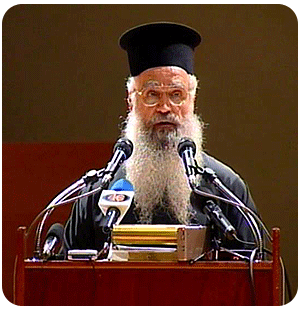 Protopresbyter Theodoros Zisis
Protopresbyter Theodoros Zisis
1. General Evaluation of the Dialogue
It is well known that among the dialogues that the Orthodox Catholic Church is conducting with the heterodox is the one with the Monophysites, or “Non-Chalcedonians,” or “Pre-Chalcedonians,” or the “Ancient Orientals,” or—as they have recently been called, contrary to Tradition—“Oriental Orthodox.” This dialogue, at the level of the Joint Theological Commission which is conducting it has ended in an agreement from which it is supposedly evident that nothing separates us in Faith, that the differences hitherto observed are due to a misunderstanding and misinterpretation of the theological terminology which the special theological experts now understand better than the Holy Fathers, and that the original separation of the Non-Chalcedonians from the Church was due not to theological but to political reasons.
This distorted picture prevailed from the inception of the discussions, both in the four unofficial conferences of Orthodox and Non-Chalcedonians that took place—it should be noted—at the initiative of the World Council of Churches, and in the official meetings of the Inter-Orthodox Commission on this dialogue and the conferences after the Joint Commission. In particular, there were persons, members of the dialogue and representatives of Churches, who believed that the “Orthodoxy” of the Non-Chalcedonians is unquestionable and beyond any dispute, and consequently that the theological dialogue is superfluous, for it will make matters more complicated. They maintained these points and proposed that the Churches should proceed to a simple proclamation of union, because the fifteen centuries of separation were unjustifiable. On this ground, consequently, the Church was in error all these centuries, and not only did the hundreds of great, illustrious, wise and enlightened Holy Fathers make a mistake in struggling and writing against the Monophysites, Jacobites, Acephalites, Severians, et al., but also the multitude of simple yet enlightened and holy Elders, who, as very many stories in the Gerontika show, did not consent even to talk with Non-Chalcedonians until the latter renounced their heresy and recognized the decisions of the Fourth Œcumenical Synod in Chalcedon.
Assuredly, the Holy Fathers and the venerable Elders did not have less love and understanding than the contemporary champions of union. On the contrary, their attitude was based on a pastoral and pedagogical concern that those who had deviated should become aware of their error and be led to the correct faith, which is the indispensable prerequisite for salvation. He who speaks the truth has love, even if he causes distress at the outset and creates a reaction, not he who misleads and conceals the truth, taking account of temporary human relations and not of eternal realities. These matters have been clarified in the conscience of the Church. There is good and bad concord and peace; bad are the concord and peace that overlook the differences in faith, because only “the unity of faith and the communion of the Holy Spirit,” for which the Church prays daily, can establish and guarantee deep and imperturbable peace, since they are based on spiritual and sacramental unity. When this unity does not exist, then we have bad and false concord and peace, which perpetuate and conceal the wound of separation and division; in these cases “better is a laudable war than a peace which severs a man from God.”[1]
The fictitious and unrealistic picture about our not having differences in faith with the Non-Chalcedonians began to be projected at the beginning of the present century, but was presented in a very alluring and attractive form in recent decades, during which the so-called Ecumenical Movement was at its zenith, before it suffered the inescapable and destructive blows that resulted from the revival and strengthening of the Roman Catholic Unia, and also from the nebulous theological syncretism and relativism of the Protestants, which finally, after its naked and open appearance at the 7th General Assembly of the World Council of Churches in Canberra, Australia (February 1991), began to trouble the Orthodox.
In any case, a fruit of this theological relativism and syncretism that they have been cultivating was the prettified picture of our differences with the Monophysites, who are no longer called such, but at first “Non-Chalcedonians,” then “Pre-Chalcedonians” or “Ancient Orientals,” and now “Orthodox,” since we have demolished the boundaries and the frontiers, despite the advice of the Fathers “not to remove the eternal boundaries which our Fathers established,” and have allowed the Monophysites, who have been heretics for fifteen centuries in the conscience of the Church, to become fellow-heirs of Orthodoxy and be called Orthodox after ourselves, without return and repentance. The theological confusion and muddle is really astonishing, as is the demolition of all the boundaries. If someone just ten years earlier were to read or hear the term “Inter-Orthodox Commission” or “Orthodox Churches,” he would surely understand a commission of Orthodox or local Orthodox Churches that belong to the Orthodox Eastern Catholic Church, which comprises the autocephalous Orthodox Churches of the East with the Church of Constantinople occupying the first place. However, this is not self-evident now; after many years of organized work by the draughtsmen of Ecumenism an “Inter-Orthodox Commission” can include Non-Chalcedonians, since with our acquiescence the Monophysite Churches of the Copts, the Syro-Jacobites, the Armenians, the Ethiopians, et al., are now numbered among the Orthodox Churches of the East. Before the Protestants the first teacher of theological and ecclesiastical syncretism was the Pope, as is most clearly evident in the institution of the Unia, where the proselytized are allowed to maintain their own distinctive traits, and even their heresies, the sole requirement being that they recognize the primacy of the Pope.
The second consequence of this theological relativism and demolition of the boundaries of the Church was the dulling of the ecclesiastical sensibility and self-awareness of many Orthodox theologians, particularly of those associated with the World Council of Churches, but also of those connected in any way with the enthusiastic ecumenist spirit that had been cultivated over many decades. This dulling, as the fruit of a supposedly objective theological investigation, which is shielded by the high-falutin names of ecumenist Orthodox theologians, is gradually beginning to assail theologians who up to now have been regarded as traditionalist. One finds it striking, for example, to evaluate and keep track of the attitude of theologians involved with the dialogue, who, on the basis of their own written texts, maintained that the way to union with the Non-Chalcedonians is difficult and that recognition of the Fourth Œcumenical Synod and the other œcumenical decisions is an indispensable condition for union, while they now welcome the union as easy and free of problems, and do not even lay down as a condition for it the recognition of the Fourth Œcumenical Synod and the other œcumenical decisions, very simply because this cannot come about, as has been declared from the side of the Non-Chalcedonians at an unofficial meeting in Geneva, even though our theologians think that by re-interpreting the decisions of the Fourth Œcumenical Synod they will persuade the Non-Chalcedonians to accept it.
It is, however, not a matter of interpretation, but of altering and overturning the decisions of the Œcumenical Synods. For example, what interpretation will we give to the definition of faith of the Seventh Œcumenical Synod in Nicæa, which recapitulates the entire Orthodox Faith, and says the following about the Monophysites and their saints: “With these Fathers we confess the two natures of Him Who for our sake was incarnate of the immaculate Theotokos and Ever-virgin Mary, recognizing that He is perfect God and perfect man, as the Synod in Chalcedon promulgated, when it expelled the blasphemers Eutyches and Dioscoros from the divine fold, rejecting along with them Severos, Peter and their interconnected band with their many blasphemies.”[2] We Orthodox regard the decisions of the Œcumenical Synods as infallible, because they were reached with the supervision of the Holy Spirit and were recognized by the conscience of the Church of all the ages. Will we, then, assail the prestige and the authority of the Œcumenical Synods with interpretations and theological sophistries, and will we provoke a schism in the perduring unity and catholicity of the Orthodox Church, forcing the Orthodox of the twentieth century to believe differently about the Non-Chalcedonians than the Orthodox of the preceding generations, especially when that faith was fortified and taught by enlightened and holy persons? Theology is not an easy thing for anyone to be able to speculate and negotiate about with the goal of creating personal and social relations. If you demolish anything, the entire edifice is demolished. The Holy Fathers knew this very well, and for this reason they recommend the renunciation of heresy and the acceptance of Orthodox teaching as the only path and method of union for the heretics. We have now excluded this method in advance, since we have already recognized them as Orthodox and placed them in the fold of the Orthodox Church, from which the Holy Fathers expelled them infallibly and in a divinely inspired way with the decisions of the Œcumenical Synods.
2. St. John of Damascus and the Non-Chalcedonians
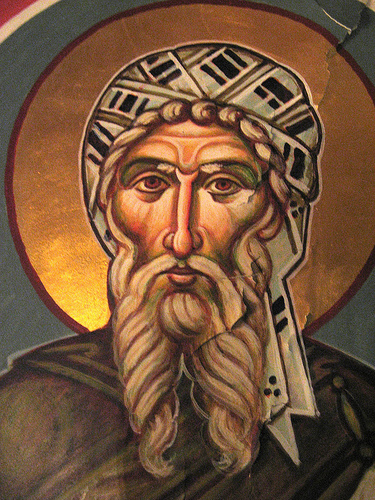 St. John of Damascus
St. John of Damascus
In reality there is not a Father and Saint of the Church throughout the age-long Tradition of the fifteen centuries, from the Fourth Œcumenical Synod until today, who would believe and teach that we do not have differences in faith with the Non-Chalcedonians and that they are essentially Orthodox as we are. On the contrary, there are many great Saints of our Church, after the Synod of Chalcedon, who set forth the depth and the breadth, in any case the extent, of the heresy of the Non-Chalcedonians. Among them are colossi and giants of theology, pillars of Orthodoxy, whose multifarious wisdom, apart from the illumination of the Holy Spirit, is astonishing and undeniable, so much superior to the wisdom of those conducting the dialogue today, that it appears risible to argue that they did not understand the reasoning and the positions of the Non-Chalcedonians and that we understand them better today. So then, did St. Maximos the Confessor, St. John of Damascus and St. Photios the Great—to mention only these three notable Fathers who dealt with the Non-Chalcedonians—not understand the issues? The bitter experience of theological dialogues leads to the conclusion that in this dialogue too the preparation of the members of the Orthodox delegation was not corporate and systematic, based on the sources of the Orthodox Faith, the texts of the Synods and Fathers, but personal, according to the theological preferences and proclivities of each member, based primarily on the contemporary bibliography that has been adulterated by the ecumenist spirit. It is certain that the topics of the dialogue would have been dealt with very differently if the Orthodox members had read the Holy Fathers—even just the three notable ones that I mentioned. In their texts one sees the same concessions and modifications on the part of the Non-Chalcedonians as are seen today, but which are judged by the Fathers to be insincere and a simple camouflage for Monophysitism, insofar as they do not lead to an explicit confession and enumeration of the two natures in Christ in the one person after the union, and consequently do not lead to the recognition of the Fourth Œcumenical Synod.
The curious thing is that while the Patristic Tradition is completely ignored, an entirely new course is mapped out, and an innovation in matters of faith is undertaken, from the prodigious mass of Patristic material one expression of St. John of Damascus is invoked ad nauseam. This expression, taken out of context and without connection to all that the golden-streaming Father of the Church of Antioch and of the Catholic Orthodox Church says in dealing with the heresy of the Acephalites or the Jacobites, leaves the impression that he recognizes them as Orthodox. The appeal to St. John of Damascus plays a catalytic role and provokes the impression that, because the Saint is considered to be the mouth of the Church, he summarizes the Faith of the Church and is in all respects an unerring teacher and norm of Orthodoxy. He is not simply considered to be, but in fact is so. For this reason the appeal to his opinion about the Non-Chalcedonians being almost Orthodox would truly constitute a strong foundation on which we could support the attempts to bring about the re-union of the Non-Chalcedonians to the Orthodox Church. If only things were so, and all this misery and bitterness of separation and division were due to semantic ambiguities and misinterpretations of terms, and to accidental historical and political reasons, especially insofar as this assessment would derive from the dogmatic teacher par excellence and exponent of the Orthodox self-understanding, St. John of Damascus, who lived far away from Constantinople in the Church of Antioch, from which the Syro-Jacobite Church originated, and knew the situation better and more closely.
However, the picture which ensues from reading the texts of St. John of Damascus is completely different, extremely unfavorable and disheartening for the possibilities of re-union with the Non-Chalcedonians, even with interpretations and explanations, unless they return to the Orthodox Church and confess the faith of Chalcedon. This discovery should make all those rushing into union circumspect and cautious, and especially the Church of Antioch whose Patriarch has for his seat the city of Damascus, the birthplace of the Saint, whom it particularly honors and reveres, as is evident from the appellation of its Theological School, which bears the name of St. John of Damascus.
But let us see in brief what is the picture that emerges from the writings of St. John of Damascus. In the first place, it is well-known that he wrote three treatises against the Jacobites or Acephalites, whom, it should be noted, he unhesitatingly calls Monophysites. The first is entitled Concerning the Composite Nature, against the Acephalites,[3] while the second, far more extensive than the first, was written at the order of Patriarch Peter of Antioch and is entitled Tome as from Peter, the Most Holy Bishop of Damascus, to the supposed Bishop of Daraia, the Jacobite.[4] The third, entitled Epistle to Archimandrite John, Concerning the Trisagion Hymn,[5] analyzes the Trinitarian character of the Trisagion Hymn contrary to the restriction of it to Christ alone that the Monophysites make, in order to justify the addition of the Theopaschite phrase “Who was crucified for us.” He who restricts the Trisagion hymn to a single Person of the Holy Trinity “shares in the vulgar stupidity of the Fuller,” and contributes to “the outrage evilly introduced by the Fuller to destroy everyone utterly.”[6] This has to do with Peter the Fuller, the Patriarch of Alexandria, who introduced the addition to the Trisagion Hymn. St. John also wrote a treatise against Monotheletism, where mention is also made of the Monophysites. It is entitled Concerning the Two Wills, Energies and Other Natural Properties in Christ by Concurrence and Concerning Two Natures and One Hypostasis.[7] We find basic references also in his best known works, Concerning Heresies in Brief, whence they began and whence they arose,[8] and Exact Exposition of the Orthodox Faith,[9] which together with the work Philosophical Chapters[10] constitute the single three-part work Fount of Knowledge. In other works also there are scattered references to the Monophysites.
The controversial phrase of St. John of Damascus, which they frequently invoke, as we said, in defense of the “Orthodoxy” of the Non-Chalcedonians, comes from the work Concerning Heresies, and as it is used in abstraction from its context it says that the Non-Chalcedonians “have separated themselves from the Church on the pretext of the Synod in Chalcedon, being Orthodox in every other way.” To begin with we shall quote the entire text of St. John, which we shall comment on in what follows, without entering for the present into the essence of his teaching, which is completely contrary to the common texts that have been signed at the dialogue, as is assuredly the common teaching of all the Fathers of the Orthodox Church, which St. John of Damascus expresses.
The text is as follows:
83. The Egyptians, who are also called Schematics and Monophysites: separated from the Orthodox Church on the pretext of the document approved at Chalcedon and known as the Tome. They have been called Egyptians because it was the Egyptians who first started this form of heresy during the reigns of the Emperors Marcian and Valentinian; in every other way they are Orthodox. Because they were attached to Dioscoros of Alexandria who was deposed by the Synod in Chalcedon for advocating the teachings of Eutyches they opposed the Synod and fabricated countless charges against it to the best of their ability. We have taken up these charges in this book and sufficiently refuted them, showing them to be clumsy and stupid. Their leaders were Theodosios of Alexandria, from who derive the Theodosians, and James [Baradaios] of Syria, from who the Jacobites derive. Privy to them, and supporters and champions, were Severos, the corrupter from Antioch, and John [Philoponos] the Tritheite, who toiled on vain things; they denied the mystery of our common salvation. They wrote many things against the God-inspired teaching of the 630 Fathers of Chalcedon, and laid many snares, so to speak, and stumbling blocks by the path (Psalm 139:6) for those who were perishing by their pernicious heresy. Nevertheless, even though they teach that there are particular substances, they confound the mystery of the Incarnation. We considered it necessary to discuss their impiety in brief, adding short notes in refutation of their godless and abominable heresy. I shall set forth the teachings, or rather, ravings, of their champion John, in which they take so much pride.[11]
The first observation we should make is that St. John lists and counts the Non-Chalcedonians among the heretics. The number 83 which precedes the text is the number of the heresy in the order in which he sets them forth. Had he believed that they were Orthodox, he would surely not have included them among the heretics. He then openly calls them Monophysites: “Egyptians, who are also called Schematics and Monophysites.” So much has been written and said in the contemporary ecumenist theological bibliography about them not being Monophysites that we are all hesitant about using this term, which tends to be abolished. Let us proceed to the notorious phrase: “separated from the Orthodox Church on the pretext of the document approved at Chalcedon and known as the Tome … in every other way they are Orthodox.” In the first section of the phrase it is clearly stated that the issue concerns schismatics who do not belong to the Orthodox Church: “separated from the Orthodox Church.” They are, then, outside the domain of the Orthodox Church. The cause of their separation from the Orthodox Church is the dogmatic definition, the document of Chalcedon, and not the various historical and political reasons that contemporary theologians and historians endeavor to find, following a non-theological method that is totally alien to the Patristic methodology and the self-understanding of the Church: “on the pretext of the document approved at Chalcedon.” St. John’s use of on the pretext worsens the position of the Non-Chalcedonians and strengthens the authority and prestige of the Fourth Œcumenical Synod of Chalcedon. In other words, he wants to say that the faith of Chalcedon is crystal-clear and does not need the kind of interpretations and explanations that we practice in the dialogue today; its rejection is a pretext for them to go into schism and division, to which their faith, divergent from the Chalcedonian definition, leads them.
What, then, is the meaning of the second part of the phrase, “in every other way they are Orthodox,” which provokes confusion? Very simply, St. John of Damascus juxtaposes to the great theological error of rejecting Chalcedon, which places the Non-Chalcedonians automatically outside the Church, the preservation on their part in the life of the Church, as also in the other matters of faith, of teachings and liturgical customs and practices, with regard to which they are Orthodox, that is to say, in agreement with Orthodox Catholic Church. Everyone knows that unity presupposes unity in faith, worship and administration, and that especially in matters of faith unity reaches even to the small points, because by reason of the coherence, cohesion and innermost connection of the truths of faith “he who damages a small part damages the whole.” Assuredly, the dogma of Chalcedon concerning the hypostatic union of the two natures in the one Person of Christ is a fundamental dogmatic teaching, the rejection of which constitutes manifest heresy, even if those who reject it “are Orthodox in every other way.” This is the position of St. John of Damascus, which is confirmed additionally by the remainder of the quotation and by his other positions. But before we proceed to them, we should say in the present context that what is said about the Non-Chalcedonians could be said also about the Arians and the Iconoclasts: that is to say, that the former separated “on the pretext of the document approved at Nicæa I,” while the latter did so “on the pretext of the document approved at Nicæa II,” “being Orthodox in every other way.” Are we to say, then, by this logic how many decrees, what kind and from what Synod the heretics reject, in order to change them into Orthodox, gradually demolishing the immovable boundaries “which our Fathers established,” dividing the body of the Church across time and “with all the Saints,” in view not of a clear return in repentance but of a vague and unclear confession of the Non-Chalcedonians?
The remainder of the quotation is much more interesting. The Non-Chalcedonians have a very high opinion of Dioscoros, who was deposed by the Synod of Chalcedon for advocating the teaching of Eutyches. For this purpose they concocted countless accusations against the Synod, which we have already dispelled, “showing them to be clumsy and stupid.” St. John mentions them in specific works of his against the Jacobites which we have mentioned. Their leaders were Theodosios from Alexandria, for which reason they are called Theodosians, and James [Baradaios] the Syrian, after whom they are called Jacobites. Allies and champions of theirs were Severos, “the corrupter from Antioch,” and John Philoponos the Tritheite, who by their teaching “deny the mystery of our common salvation.” They wrote many things against “the God-inspired teaching of the 630 Fathers,” seducing and destroying many people in “their pernicious heresy.”
The brief reference to their impious teaching and the small interpolated notes were for the purpose of refuting “their godless and abominable heresy.”
When these points are transferred to the contemporary theological reality they indicate the following. St. John does not doubt the correctness of the condemnation of Dioscoros—whom many Orthodox now exonerate—on the ground that he defended the heresy of Eutyches in a synod. The words “Dioscoros was not deposed for reasons of faith,” which Patriarch Anatolios uttered and which became a slogan at the dialogue, as did “being Orthodox in every other way,” do not signify that his Orthodoxy was recognized, but simply that, after being summoned to come to the Synod, he did not come, and was deposed for this canonical infraction of his and not “for reasons of faith,” as is most clearly evident in the commentary by Leontios that is quoted here in the footnote. If, however, he were to come, he would be deposed for reasons of faith, because he was a heretic.[12]
The reservations and accusations of the Non-Chalcedonians against Chalcedon are rejected by St. John without question as groundless. In the contemporary dialogue the Orthodox are attempting to interpret and justify the Synod of Chalcedon by adopting in many respects the criticisms of the Non-Chalcedonians, and especially their fury against St. Leo the Pope of Rome, who supposedly enticed the Synod to his own Nestorianizing positions and split the Easterners, and is entirely responsible for the schism and division of the Eastern world, which the dialogue is now trying to correct and heal. A consequence of this virulence against St. Leo is the effort being made even at the level of theological research to show the “Cyrilline character” of the Chalcedonian definition and to alienate St. Leo from the decisions of the Synod, so that they may in this way be accepted by the Non-Chalcedonians.
To be sure, this adoption—unprecedented and unique in the history of the Orthodox Church—of the accusations of heretics against the protagonists and champions of the Faith, among whom is St. Leo, the great and most Orthodox pillar of the Church, the tower and bulwark of piety,[13] led to the point of view being formulated that Leo does not concern the dialogue of Orthodox and Anti-Chalcedonians, but that of Roman Catholics and Non-Chalcedonians. However, the Faith of the undivided Church is Catholic; as Rome believed, so did Constantinople, Alexandria and Antioch, and conversely, as the smallest diocese and parish believed, so did the large ecclesiastical centers. Consequently it concerns them all. Woe to us if we transfer the conditions after the schism to the era before the schism and make the Saints of the Church responsible for our own unworthiness.
Separation, division and schism from the Church, according to St. John of Damascus, indicate a privation of the potential for salvation. By their teaching the Non-Chalcedonians deny “the common mystery of salvation.” Those who are enticed and those who entice them to their heresy, as is the case with every heresy, are destroyed, lose their salvation, and are led into perdition. We all accept and teach that the core and goal of the dogmatic teaching and struggles of the Saints and Fathers were not philological and hermeneutical disputes and semantic clarifications, but the safeguarding of the potential for salvation which the heretics destroy. Moreover, we accept that this is why the entire struggle took place—not so that this or that opinion might be victorious, but so that men might be saved. However, in today’s theological dialogues the position tends to prevail that we all constitute Churches and are all saved in them—that we are Sister Churches or families of Churches which do not have great differences in faith, but that we simply do not agree in terminology and that we interpret some matters differently. For this reason we give some explanations for these differences, and everyone remains where he is. The Oriental Orthodox, that is, the Non-Chalcedonians, can preserve the Cyrilline terminology of the one nature of the Incarnate Word that is traditional for them, while we Orthodox are entitled to use the formulation of two natures, as the texts of the Dialogue say.[14] These terms have no repercussion for salvation, nor did they have any hitherto, and the Holy Fathers and St. John of Damascus made a mistake in seeing the Non-Chalcedonians as lost in heresy, outside the Church, and in attempting, not to flatter them, but to return them to the fold of the Church. Those who conduct the dialogues today write to the contrary of the Holy Fathers: “We now understand clearly that both families always preserved faithfully the authentic Orthodox Christological faith and the unbroken continuity of the Apostolic Tradition, although they used Christological terms in a different way.”[15]
Concluding remarks
Our intention was to set forth and comment on texts of St. John of Damascus and particularly his works against the Non-Chalcedonian Monophysites, in order to show that the appeal to him as a witness to their Orthodoxy does not correspond to the facts. This appeal was very clearly made solely on the basis of the quotation from his work Concerning Heresies. In fact the whole picture that one takes away from the totality of his writings is best conveyed in this summary, as he himself says, which criticizes “their godless and abominable heresy,” within which those who find themselves lose their salvation. In the wake of these points it is obvious how Orthodox the Oriental “Orthodox” are and how much optimism there should be for the success of their union with the Orthodox Church, insofar as we continue to believe that the Saint of Damascus, the boast of the Church of Antioch, is the mouth of the Church, the voice of the Fathers and the Synods.
* * *
Originally appeared in Gregorios Ho Palamas, no. 744 (September-October, 1992), pp. 1133-1144.
